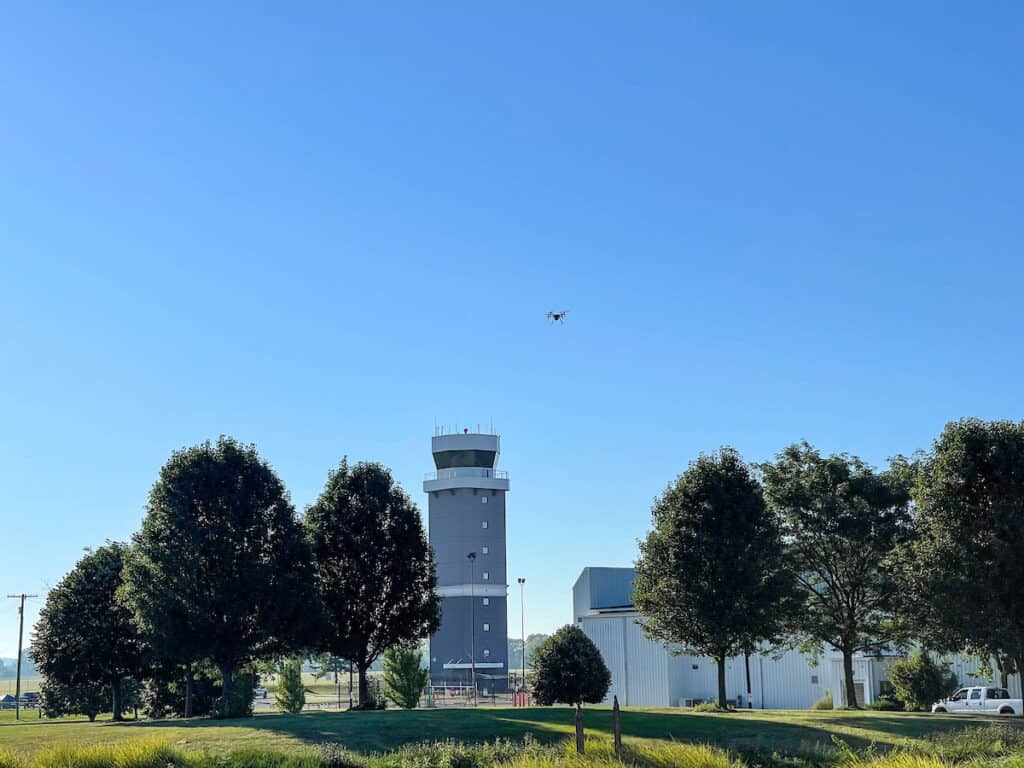As technology advances, drones or unmanned aircraft systems (UAS) are increasingly sharing the skies with traditional aircraft. Ensuring safety remains paramount. Congress tasked the Federal Aviation Administration (FAA) to create the groundbreaking Unmanned Aircraft Systems (UAS) Detection and Mitigation Research Program to shape guidance for airports and ensure drones don’t cause harm or interference to the FAA’s National Airspace System. Rickenbacker International Airport (LCK) stepped up to the challenge and became a vital contributor to shaping the future of drone safety.
Answering the call
In late summer 2020, the FAA issued a call for proposals, inviting airports across the country to participate in this crucial research program. Columbus Regional Airport Authority (CRAA) staff Luke Curtis, Supervisor, Airport Operations; Charles Goodwin, Chief Development Officer; and Kristen Easterday, Director, Communications & Public Affairs, crafted a proposal outlining Rickenbacker’s capabilities and potential involvement in the project. Their efforts were rewarded in March 2021 when FAA officials selected LCK as one of five airports nationwide to host this research.
Research takes flight
After months of preparation, the FAA began their research at Rickenbacker in late summer 2022. The project aimed to explore and evaluate a wide array of cutting-edge technologies designed to detect and mitigate potential safety risks posed by drones in the airport environment. The research area encompassed not only the airfield itself but also extended to a five-mile radius beyond the airport’s fence lines.
The research team, consisting of experts from the FAA and industry partners, tested and assessed two detection systems, including four unique detection technologies, and one mitigation system, and conducted over 1,828 UAS flights at LCK. Their objective was to assess the capabilities of these systems and technologies in addressing potential airspace interference from drones.
By the numbers:
- 5 airports were chosen by the FAA to host this research: Rickenbacker, Syracuse, Huntsville, and Atlantic City.
- 14,000+ UAS flights were flown by research teams during the program.
- 30+ different technologies were evaluated.
A collaborative effort for a safer future
Throughout the program, LCK served as a real-world testing ground for evaluating the capabilities of drone detection and mitigation technologies. This invaluable data will contribute to the development of national standards and guidance for airports across the country, ensuring a consistent and effective approach to managing drone activity in the vicinity of airports.
“The team at Rickenbacker was great to work with,” said Jim Patterson, Manager, UAS Detection and Mitigation Program. “They provided office space, Wi-Fi, escorts, and insight about a cargo-focused airport near a military unit. Rickenbacker is a unique airport and we learned a lot about how this program should be shaped.”
Beyond the research
Rickenbacker’s involvement in the FAA’s drone detection and mitigation program underscores our unwavering dedication to safety and innovation. By participating in this research, we’re helping to pave the way for the safe and responsible integration of drones into the national airspace system and there may be opportunities to collaborate with the FAA again.
“We have a different approach to drones than other airports,” said Josh Burger, Manager, Airport Operations, CRAA. “What we need from a UAS detection and mitigation program is different than what another airport needs. We have the military and cargo components to consider while other airports have different considerations.”
As drones continue to become more prevalent in various industries and everyday life, we can proudly say that LCK is part of ensuring unmanned aircraft can coexist harmoniously with traditional aviation.
“We participated in this program to be at the forefront of this emerging technology and help shape the FAA guidance for all airports nationwide,” explained Luke Curtis, Supervisor, Airport Operations, CRAA. “The FAA selected us to be a leader in this process and this gave us an opportunity to put our stamp on the future of drones and aviation.”
Did you know?
- If a drone is spotted in our airspace, airport staff must notify law enforcement. As civilians, we are not allowed to mitigate a drone because they are considered aircraft.
- The FAA’s William J Hughes Technical Center for Advanced Aerospace is in Atlantic City, NJ.
- As of August 8, 2024, there are 785,827 drones and 406,094 certified UAS remote pilots registered in the US.
- Rickenbacker and the FAA are exploring numerous applications that UAS can be used to conduct safe, meaningful tasks at the airport. Applications like pavement inspections, wildlife management, and incident monitoring are just a few of the exciting concepts being explored.




